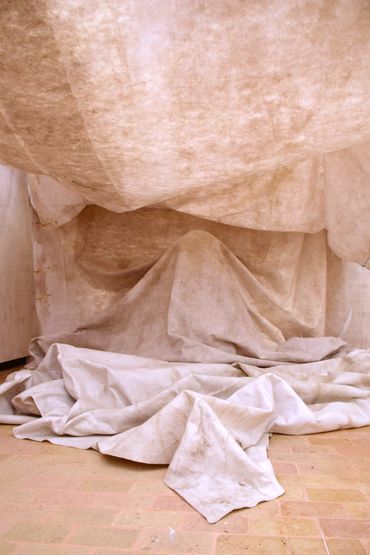Obiettivo 13, Villa Manin, Italy
It is just a piece of cloth, hanging from the ceiling.
It is a shroud, covering the body of a dying glacier.
The cloth originates from the Italian Alps, at the border between Trentino and Lombardia. It is a remnant of over 100,000 square meters of similar material used each year to cover the Presena Glacier. The purpose is to shield it from climate change, helping its snow survive the increasingly hot summers.
What might seem like environmental protection is, in fact, environmental exploitation. Only the portion designated as a ski slope is covered. The rest is left bare, with the underlying rock exposed to the relentless summer sun. At the start of the ski season, the contrast is stark: barren rock lies beside meters of compacted snow protected under the textile.
This material—an industrial geotextile made of non-woven, high-tenacity polypropylene—bears the imprint of the mountain it once covered. Made of virgin plastic, the textile is typically incinerated after just one summer. What is used to mitigate climate change locally ultimately contributes to climate change globally.
As such, the material becomes a powerful symbol of our complex and often contradictory relationship with the natural environment, as well as our broader responsibilities in the Anthropocene era.
Hung in the setting of Villa Manin as a classic "Drappeggio" study, this shroud invites visitors to pause for reflection and contemplate our role as a planetary species.








Concept
In northern Italy's Trentino region, an annual effort takes place to preserve the Presena Glacier from climate change. Initiated in 2008, workers cover the glacier with large industrial textiles, preventing its melting due to rising temperatures. The covered area has grown to about 120,000 square meters, using petroleum-derived textiles with a limited lifespan of around two years. This paradoxical act, burning 34 tonnes of plastics annually, releases approximately 20 tonnes of CO2.